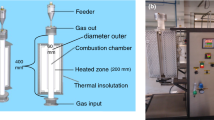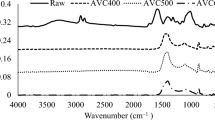Abstract
Bioenergy is considered as a sustainable energy which can play a significant role in the future’s energy scenarios to replace fossil fuels, not only in the heat production, but also in the electricity and transportation sectors. Emission formation and release of main ash-forming elements during thermal conversion of biomass fuels at different conditions have been the scope of this study. The experiments were conducted in a quartz glass reactor where the temperature and atmosphere could be controlled. The selected fuels represent a wide range of biomass compositions. They are torrefied softwood, spruce bark, waste wood, miscanthus, and wheat straw. The fuels were first grinded and then pressed with a pellet maker into pellets of the same size and weight. For each fuel, the experiments were carried out under both oxidation and pyrolysis condition, with atmosphere of 3 % O2 + 97 % N2 and 100 % N2, respectively, at four residence times. The selected temperatures under which experiments were performed are 800, 900, and 1,050 °C. The concentration of SO2, NO, CO, and CO2 emissions and O2 were monitored online by three analysers, simultaneously. The residue weight was measured after each process, and the comparison with the ash content of the fresh pellet is made. Additionally, the release of several ash-forming elements (K, Zn, Na, and Mn) from the fuels has been quantified as function of temperature and residence time by inductively coupled plasma mass spectrometry (ICP-MS) and inductively coupled plasma atomic emission spectroscopy (ICP-AES). Time-dependent formation of NO and SO2 and other emissions is presented and discussed with respect to different temperature and combustion conditions.









Similar content being viewed by others
Abbreviations
- AES:
-
Atomic emission spectroscopy
- BRISK:
-
Biofuels Research Infrastructure for Sharing Knowledge
- ELPI:
-
Electrical low-pressure impactor
- ERA-net:
-
European Research Area network
- EU:
-
European Union
- FC:
-
Fixed carbon
- ICP:
-
Inductively coupled plasma
- IEA:
-
International Energy Agency
- MS:
-
Mass spectrometry
- OES:
-
Optical emission spectroscopy
- ÖNORM:
-
Österreichisches Normungsinstitut (Austrian Standards Institute)
- SciToBiCom:
-
Scientific tools for fuel characterization for clean and efficient biomass combustion
- SEM:
-
Scanning electron microscope
- VM:
-
Volatile matter
References
Barmina I, Lickrastina A, Zake M, Arshanitsa A, Solodovnik V, Telisheva G (2012) Effect of main characteristics of pelletized renewable energy resources on combustion characteristics and heat energy production. Chem Eng Trans 29:901–906. doi:10.3303/CET1229151
Bauen A, Berndes G, Junginger M, Londo M, Vuille F (2009) Bioenergy: a sustainable and reliable energy source: a review of status and prospects. IEA Bioenergy
Čuček L, Klemeš J, Kravanja Z (2012) Carbon and nitrogen trade-offs in biomass energy production. Clean Technol Environ Policy 14(3):389–397. doi:10.1007/s10098-012-0468-3
Davidsson KO, Korsgren JG, Pettersson JBC, Jäglid U (2002) The effects of fuel washing techniques on alkali release from biomass. Fuel 81(2):137–142. doi:10.1016/S0016-2361(01)00132-6
Dvořák R, Smejkal Q, Hanák L, Jedlička F, Stehlík P (2011) Efficiency increase of secondary DeNOx systems for cleaning of flue gas produced in combustion processes. Chem Eng Trans 25:321–326. doi:10.3303/CET1125054
Glarborg P, Jensen AD, Johnsson JE (2003) Fuel nitrogen conversion in solid fuel fired systems. Prog Energ Combust 29(2):89–113. doi:10.1016/S0360-1285(02)00031-X
Houshfar E, Skreiberg Ø, Løvås T, Todorović D, Sørum L (2011) Effect of excess air ratio and temperature on NO x emission from grate combustion of biomass in the staged air combustion scenario. Energ Fuel 25(10):4643–4654. doi:10.1021/ef200714d
Houshfar E, Skreiberg Ø, Todorović D, Skreiberg A, Løvås T, Jovović A, Sørum L (2012) NO x emission reduction by staged combustion in grate combustion of biomass fuels and fuel mixtures. Fuel 98:29–40. doi:10.1016/j.fuel.2012.03.044
Hupa M (2011) Ash-related issues in fluidized-bed combustion of biomasses: recent research highlights. Energ Fuel 26(1):4–14. doi:10.1021/ef201169k
Jiang X, Huang X, Liu J, Han X (2010) NO x emission of fine- and superfine-pulverized coal combustion in O2/CO2 atmosphere. Energ Fuel 24(12):6307–6313. doi:10.1021/ef101029e
Johansen JM, Jakobsen JG, Frandsen FJ, Glarborg P (2011) Release of K, Cl, and S during pyrolysis and combustion of high-chlorine biomass. Energ Fuel 25(11):4961–4971. doi:10.1021/ef201098n
Karlström O, Brink A, Hupa M (2013) Time dependent production of NO from combustion of large biomass char particles. Fuel 103:524–532. doi:10.1016/j.fuel.2012.06.030
Khalil RA, Houshfar E, Musinguzi W, Becidan M, Skreiberg Ø, Goile F, Løvås T, Sørum L (2011) Experimental investigation on corrosion abatement in straw combustion by fuel-mixing. Energ Fuel 25(6):2687–2695. doi:10.1021/ef200232r
Kilpinen P, Kallio S, Konttinen J, Barišić V (2002) Char-nitrogen oxidation under fluidised bed combustion conditions: single particle studies. Fuel 81(18):2349–2362. doi:10.1016/S0016-2361(02)00176-X
Knudsen JN, Jensen PA, Dam-Johansen K (2004) Transformation and release to the gas phase of Cl, K, and S during combustion of annual biomass. Energ Fuel 18(5):1385–1399. doi:10.1021/ef049944q
Kravanja P, Könighofer K, Canella L, Jungmeier G, Friedl A (2012) Perspectives for the production of bioethanol from wood and straw in Austria: technical, economic, and ecological aspects. Clean Technol Environ Policy 14(3):411–425. doi:10.1007/s10098-011-0438-1
Kymäläinen M, Janka K, Keskinen J, Moisio M, Backman R, Hupa M (1996) Measurement of time-dependent fume release rate during black liquor pyrolysis. J Pulp Pap Sci 22:17–23
Nussbaumer T (2003) Combustion and co-combustion of biomass: fundamentals, technologies, and primary measures for emission reduction. Energ Fuel 17(6):1510–1521. doi:10.1021/Ef030031q
Okuno T, Sonoyama N, Hayashi J-I, Li C-Z, Sathe C, Chiba T (2005) Primary release of alkali and alkaline earth metallic species during the pyrolysis of pulverized biomass. Energ Fuel 19(5):2164–2171. doi: 10.1021/ef050002a
Shah KV, Cieplik MK, Betrand CI, van de Kamp WL, Vuthaluru HB (2010) Correlating the effects of ash elements and their association in the fuel matrix with the ash release during pulverized fuel combustion. Fuel Process Technol 91(5):531–545. doi:10.1016/j.fuproc.2009.12.016
Sippula O, Lind T, Jokiniemi J (2008) Effects of chlorine and sulphur on particle formation in wood combustion performed in a laboratory scale reactor. Fuel 87(12):2425–2436. doi:10.1016/j.fuel.2008.02.004
Skreiberg Ø, Hustad JE, Karlsvik E (1997) Empirical NO x -modelling and experimental results from wood stove combustion. In: Bridgwater AV, Boocock DGB (eds) Developments in thermochemical biomass conversion, Banff, Canada, 1996. Blackie Academic & Professional, London, pp 1462–1478
Vähä-Savo N, DeMartini N, Hupa M (2011) Combustion of black liquor-solid biomass mixtures in a single particle reactor—characteristics and fate of nitrogen. Energ Fuel 25(11):4944–4951. doi:10.1021/ef2009937
Wei X, Schnell U, Han X, Hein KRG (2004) Interactions of CO, HCl, and SO x in pulverised coal flames. Fuel 83(9):1227–1233. doi:10.1016/j.fuel.2003.12.004
Werther J, Saenger M, Hartge EU, Ogada T, Siagi Z (2000) Combustion of agricultural residues. Prog Energ Combust 26(1):1–27
Winter F, Wartha C, Hofbauer H (1999) NO and N2O formation during the combustion of wood, straw, malt waste and peat. Bioresour Technol 70(1):39–49. doi:10.1016/s0960-8524(99)00019-x
Acknowledgments
The authors wish to acknowledge the financial support from the BRISK project (Biofuels Research Infrastructure for Sharing Knowledge). We also thank Bioenergy2020+ and DTU—Technical University of Denmark—for providing fuels through SciToBiCom ERA-net Bioenergy project (Scientific tools for fuel characterization for clean and efficient biomass combustion). The authors would also like to thank Mr. Luis Bezerra from Åbo Akademi University for assisting the experimental setup.
Author information
Authors and Affiliations
Corresponding author
Rights and permissions
About this article
Cite this article
Houshfar, E., Wang, L., Vähä-Savo, N. et al. Characterisation of CO/NO/SO2 emission and ash-forming elements from the combustion and pyrolysis process. Clean Techn Environ Policy 16, 1339–1351 (2014). https://doi.org/10.1007/s10098-014-0762-3
Received:
Accepted:
Published:
Issue Date:
DOI: https://doi.org/10.1007/s10098-014-0762-3




